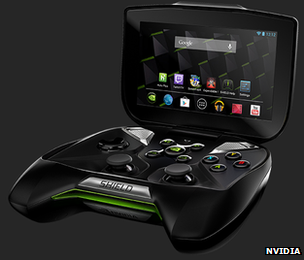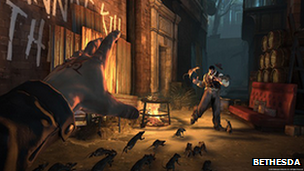Nvidia's Shield console gets price and release date
- Published

Shield was first unveiled at the Consumer Electronics Show in January
US chipmaker Nvidia has revealed its launch plans for Shield - its handheld video-games console.
It says the Android-powered device will ship to North America in June and be priced at $349 (£229).
That makes it $100 more expensive than Sony's PlayStation Vita and nearly double the cost of Nintendo's 3DS XL.
One expert said Shield was unlikely to appeal to more than a "niche audience" but it would act as a showpiece for Nvidia's technology.
The console is equipped with the firm's Tegra 4 chip - its new top-end mobile processor.
The ARM-based component features 72 graphic processing unit (GPU) cores and four central processing unit (CPU) cores. Nvidia says this allows it to offer "rich graphics and unbeatable performance".
The firm is pitching its chip as an alternative to Qualcomm's popular Snapdragon processors, which are used in high-end Android devices such as Samsung's Galaxy S4 and the HTC One.
"The market for handheld consoles is struggling in face of competition from smartphones, so the first question you have to ask yourself is what is the market for a dedicated Android gaming device," Ben Parfitt, online editor at games industry trade magazine MCV, told the BBC.
"Even if you believe a market exists, $349 is a lot of money. People aren't spending that at the moment on the Wii U which is a home console, I find it hard to believe they'd spend it on a handheld."
Streaming PC games
Shield does offer features not found in either Sony or Nintendo's portable consoles.

The PC-streaming feature lets Shield play games which would be too demanding for its own processor
Its 5in (12.7cm) screen displays 720p high definition video; it has a more powerful speaker system; and its mini-HDMI port can output 4K resolution visuals to compatible televisions.
In addition to running titles available from the Google Play and Tegrazone Android marketplaces, it can also stream more advanced titles bought from Valve's Steam platform and run on a wi-fi connected PC.
"These pieces, put together by a company full of gaming fanatics, add up to an amazing new open platform gaming portable," Nvidia said on its blog, external.
After a hands-on test, the Techradar news site praised the variety of controls offered by the device, but noted that its 294 pixel per inch (ppi) resolution screen was outclassed by many smartphones.
"That was nothing to sneeze at a few years ago, but now your average smart phone is rocking ppi in the mid-300s," it said. "The new HTC One has 440 ppi."
Mr Parfitt also questioned the appeal of one of its other unique selling points.
"Streaming PC games is something you can't do on rival devices and that is a great feature," he said.
"But you have to have a compatible Nvidia graphics card in your PC - one of the reasonably new ones - so that will cut down the audience for that. And do the people who invest in high-end gaming on PCs want a portable as well? I don't know."
Nvidia said Steam would ship with two titles optimised for the handheld: Sega's Sonic 4 Episode II, and Retrobomb's Expendable Rearmed.
It added that it had started taking pre-orders from selected customers, and would open up sales to others from 20 May.
- Published7 January 2013
- Published8 April 2013
- Published28 March 2013